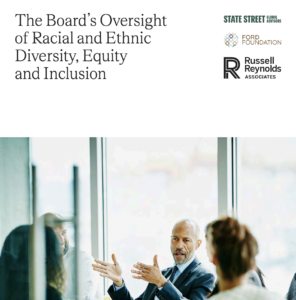Strategy, Compensation Metrics, and Board Oversight Can Drive Racial Equity Goals

Conversations about racial equity, including Diversity, Equity, and Inclusion (DEI), have evolved – and should continue to evolve – at the corporate board level. Previously, one underrepresented racially or ethnically diverse person in a board seat was labeled as an achievement. Today, leading companies and their boards consider racial equity and DEI as part of their overall business strategy, including talent development as well as risk assessment.
As part of our ongoing work in this space, we were delighted to co-host the Second Annual Racial Equity in Corporate Governance Virtual Conference, a series of three panels with the Institute for Law & Economics at the University of Pennsylvania, the Ira M. Millstein Center for Global Markets and Corporate Ownership at Columbia Law School, and the Arthur and Toni Rembe Rock Center for Corporate Governance at Stanford University.
George Brown, our executive director, moderated the conference’s opening panel, The Role of Public Company Board of Directors (click for full video). Joining him were:
- Benjamin Colton, Global Head of Asset Stewardship, Voting & Engagement, State Street Global Advisors
- Maria Elena (Mel) Lagomasino, CEO and Managing Partner, WE Family Offices; board member with The Coca-Cola Company and The Walt Disney Company
- Barry Lawson Williams, Entrepreneur, Retired Managing General Partner, The Williams Companies; Corporate Director for 14 public companies
All three panelists spoke about the growing role of racial equity, DEI, and its place in board conversations and company operations. Below are key takeaways (click on the hyperlinks for video highlights) for the consideration of public company boards.
Racial equity and DEI are business mandates
Shareholders are increasingly interested in how racial equity and DEI – like similar business strategies and risk assessments – are being addressed, measured, and implemented. For example, Ben Colton and State Street Global Advisors (SSGA) believe they have a fiduciary responsibility to ensure the full board is addressing its DEI risk and incorporating it into strategy. He explained that SSGA is asking companies to be clear how DEI fits in its business – and which measuring tools, such as key performance indicators and target setting, can demonstrate the company’s focus on DEI. “The board is responsible for strategy,” Colton said, “and DEI should be an integral part of such strategy.” DEI also has to be part of the company’s values and purpose for it to truly have impact, said Mel Lagomasino. She added that DEI can best be implemented as part of a company’s talent strategy, ensuring that the pipeline remains diverse and inclusive. “It’s multidimensional … How do you create a sense of belonging in the company so that inclusion of your talent is such that it keeps growing? This starts with the board, it starts with your directors. Are they diverse? Do they understand the importance of diversity and racial equity?”

Racial equity and DEI oversight needs to happen at both the board and committee levels
DEI as both a part of risk assessment and overall business strategy means the discussion should be elevated to the board and committee levels. Discussion at the board level ensures that all directors are involved and signals to the organization that DEI is a priority. When DEI is assigned to a specific committee, those invested individuals are able to have deeper and granular conversations on implementation. Barry Williams emphasized that each company is different and the responsibility could fall into one or more committees, such as audit, talent, policy, or compensation. Ultimately, no one director or committee should bear responsibility for carrying the conversation – and it should always come back to the full board. “If you want to prioritize something, you have to put it at the board level and get the CEO involved. Diversity eventually has to be a standing item in the board’s agenda,” he said. Furthermore, diverse boards and directors who understand racial equity play a major role in the success of any DEI initiative. Without involvement from the top, many of these DEI initiatives will remain as conversations without action, said Williams and Lagomasino. “If you have a CEO that does not believe in (board diversity),” she said, “then it’s never going to happen.”
Measuring performance starts with compensation
Progress must be measured. All three panelists agreed that incentivizing thoughtful approaches and implementation for DEI with pay can be an effective way to ensure forward movement. At Disney for example, Lagomasino cited that DEI metrics were set up to address specific roles – one metric could be for retaining talent, another for delivering inclusive content. At SSGA, Colton finds that DEI metrics are an effective mechanism, not just as a pay incentive but also as an act of accountability when targets and goals are not met. He has seen examples of executive pay tied to minority employee survey results, which also included robust indicators and targets that were independently calculated. Williams, from his many years of experience on public company boards, emphasized that DEI metrics also need to be direct and drive everyday performance, not a pay modifier – such as an increasing or decreasing payout at varying intervals of accomplishment.

Diversity implementation is here to stay
From California regulations to activist shareholders, everyone is paying attention to how public companies move towards racial equity. California mandates currently require at least one diverse candidate on the board for companies headquartered in the state. In Colton’s experience, activist shareholders are now including diversity practices in their deck presentations and taking diversity into consideration when proposing proxy contest slates. State Street’s research, “The Board’s Oversight of Racial and Ethnic Diversity, Equity and Inclusion,” has been influential in providing a roadmap for how companies can more effectively manage and mitigate risks related to racial justice. “Customers and employees take this seriously. It’s important for talent retention and corporate culture,” Colton said. “I think we’ve had a lot of impact because we’ve not only been clear about our expectations, and being progressive on these issues, but also because we have accountability mechanisms.”
— Crystal Milo
